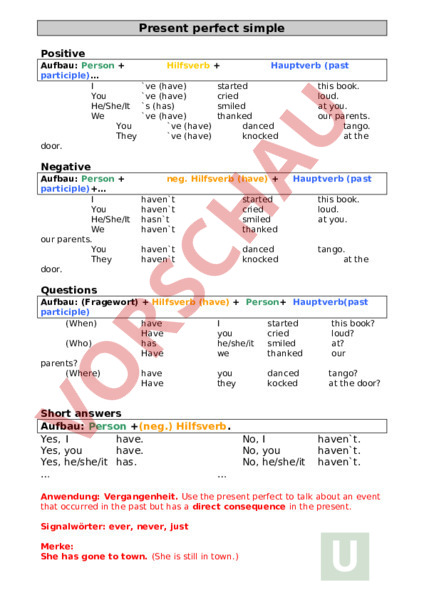Arbeitsblatt: present perfect
Material-Details
Zeigt die Anwendung, den Aufbau und die Signalwärter der grammatikalischen Zeit "present perfect".
Englisch
Grammatik
8. Schuljahr
1 Seiten
Statistik
202775
769
7
10.08.2022
Autor/in
Sibylle Süess
Land: Schweiz
Registriert vor 2006
Textauszüge aus dem Inhalt:
Present perfect simple Positive Aufbau: Person participle) You He/She/It We You They door. Hilfsverb ve (have) ve (have) (has) ve (have) ve (have) ve (have) Hauptverb (past started cried smiled thanked danced knocked this book. loud. at you. our parents. tango. at the neg. Hilfsverb (have) Hauptverb (past Negative Aufbau: Person participle) You He/She/It We our parents. You They door. havent havent hasnt havent started cried smiled thanked this book. loud. at you. havent havent danced knocked tango. at the Questions Aufbau: (Fragewort) Hilfsverb (have) Person Hauptverb(past participle) (When) have started this book? Have you cried loud? (Who) has he/she/it smiled at? Have we thanked our parents? (Where) have you danced tango? Have they kocked at the door? Short answers Aufbau: Person (neg.) Hilfsverb. Yes, have. Yes, you have. Yes, he/she/it has. No, No, you No, he/she/it havent. havent. havent. Anwendung: Vergangenheit. Use the present perfect to talk about an event that occurred in the past but has direct consequence in the present. Signalwörter: ever, never, just Merke: She has gone to town. (She is still in town.) She has been to town. (She has gone and come back. She isnt in town now.)
